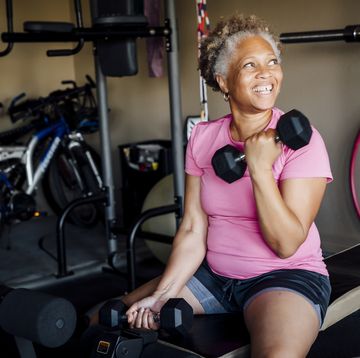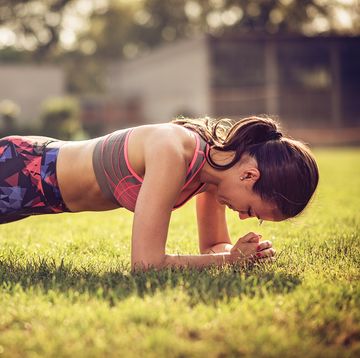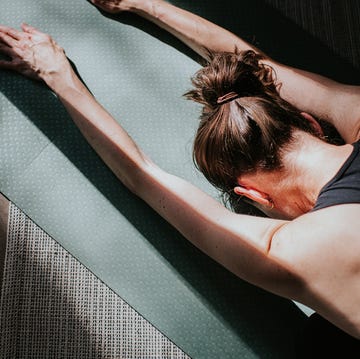One of the most common complaints we hear from veteran walkers is "I'm not seeing any results." Prevention's former fitness director, Michele Stanten, isn't surprised. "It's easy to slack off because walking is such a comfortable, familiar activity. If your goal is to slim down, you need to keep up a faster pace."
For Karen Liptrap, 40, it wasn't until she broke 4 miles per hour that her body started to respond and burn more calories. "My tush used to hang," says the mother of three from Oakville, Ontario, who started walking 4 years ago. "Now it's firm, and my legs are strong and toned." (Got 10 minutes? Then you've got time to lose the weight for good with Prevention's new 10-minute workouts and 10-minute meals. Get Fit in 10: Slim and Strong for Life now!)
To understand why Liptrap shaped up, just do the math. The faster you walk, the more calories you burn. For example, a 60-minute walk at 3 MPH burns 240 calories (based on a 150-lb person). Speed up to 4 MPH, and you can blast those calories in just 42 minutes. Keep it up for an hour, and you'll burn nearly 50% more calories—364 total. At that pace, walking 5 days a week, you could lose an extra 10 pounds a year.
MORE: 9 Proven Ways To Lose Stubborn Belly Fat
And those are just the visible benefits. "Ramping up your speed trains the heart, lungs, and skeletal muscles to use oxygen more efficiently," explains Brian Duscha, an exercise physiologist at Duke University Medical Center. Researchers at the University of Michigan also found that women who walked at 4.2 MPH for 15 weeks increased their bone density, while those who walked 3.4 MPH saw their bone density decrease.
Results like these are just a few quick steps away with this 8-week speed training program, developed by Boston-based walking expert and biomechanist Mark Fenton. The Short & Fast walk (see box and chart below) teaches your nerves and muscles to react quicker so your legs move faster; the Long & Steady walk progressively builds endurance and trains your body to sustain a faster speed for a period of 30 minutes or more. Do each of these speed walks once a week and a moderate-paced walk two to four times a week. Supplement your walks with the Muscle Up Your Speed routine three times a week, and soon you'll be blazing a trail to health—and leaving everybody else in the dust.
MORE: 13 Ways To Lower Blood Pressure Naturally
Muscle Up Your Speed
The stronger you are, the easier it is to go fast. "Strong muscles let you recruit more muscle power to propel you forward and also improve posture," says walking coach Lee Scott, founder of WoW Power Walk in Oakville, Ontario. Do these exercises three times a week, allowing at least one rest day between sessions.
You'll need a resistance exercise band (available at most sporting goods stores) for some of the moves. Aim to do 8 to 12 repetitions of each exercise. If you can't do 8 reps, use a stretchier, more flexible band; if you can do more than 12, shorten your band or use a stiffer one for more resistance.
Leg Adduction
Strengthens inner thighs to balance leg strength (walking works the outer thighs) and reduce risk of knee injuries
Attach band around bottom of a post or other sturdy object so it forms a loop. Place band around left ankle. Stand with left hip to post, far enough away so band is taut. Contract left inner thigh and pull left foot across and in front of you until foot is under right hip (pictured). Slowly release and repeat. Complete a set, switch sides, and repeat with right leg.
Kneeling Row
Strengthens arms, shoulders, and upper back for a more powerful arm swing and better posture
Kneel on right knee about arm's length from a post or other sturdy object, and attach band to object at hip height. Holding post with left hand for balance, grasp band with right hand, arm extended in front of you. Squeezing shoulder blades, bend right elbow back and slowly pull hand to hip (pictured). Pause, then slowly release and repeat. Complete a set of reps, switch legs, and repeat with left arm.
MORE: No Squats Belly, Butt, And Thighs Workout
Toe Pulls
Strengthen shins so they won't burn when you pick up the pace
A. Attach band around bottom of post. Sit facing post with right leg outstretched and band hooked around right foot. Band should be taut; if not, move back.
B. Flex right foot, pulling toes toward knee. Pause, then slowly release and repeat. Complete a set of reps, switch legs, and repeat with left foot.
Progressive Lunges
Strengthen buttocks and hamstrings, the large muscles that power each stride
Do each phase for at least 2 weeks, progressing to the next level when you can easily complete 12 reps with each leg.
Phase 1: Stand with hands on hips and left foot about 3 feet in front of right foot, right heel off ground. Bend knees and lower hips 6 to 8 inches, keeping left knee behind toes and body weight balanced evenly over left heel and right toes (pictured; if you can't see front toes beyond knee, spread feet farther apart). Pause, then straighten legs and repeat. Complete a set of reps, switch legs, and repeat.
Phase 2: Start as in Phase 1. As you straighten legs, push off right foot and step it next to left foot to end in standing position. Step right foot back to start and repeat for one set. Switch legs and repeat.
Phase 3: Stand with feet together. Step left foot forward and lower into lunge. Push off with right foot and stand back up, feet together. Repeat with opposite leg and continue alternating legs, traveling forward.
Phase 4: Repeat Phase 3, but instead of bringing feet together as you return to standing, step back foot all the way forward into the next lunge.
MORE: 6 Moves That Target Stubborn Cellulite
3 Tips for Faster Walking
Use your toes
Your foot should roll smoothly from heel to toe. Propel yourself forward by pushing off with the toes of your back foot. For a more powerful push-off, drive your toes back and raise the heel as if you were showing a walker behind you the sole of your shoe.
Pump your arms
You'll get more drive for each stride if you bend your elbows 90 degrees. Pull your elbow back so your hand is by your hip, then let it swing forward in an arc to about chest height. Don't let your arms swing out to the side; it'll slow you down.
Don't overstride
Reaching forward with your front foot slows you down and can lead to a back or hamstring injury. Focus on extending the leg that pushes off behind you, and then pull that leg forward once you finish the push-off.















